Back to Journals » Journal of Multidisciplinary Healthcare » Volume 11
The evolving role of social media in health-care delivery: measuring the perception of health-care professionals in Eastern Saudi Arabia
Authors Alshakhs F , Alanzi T
Received 18 April 2018
Accepted for publication 14 June 2018
Published 21 September 2018 Volume 2018:11 Pages 473—479
DOI https://doi.org/10.2147/JMDH.S171538
Checked for plagiarism Yes
Review by Single anonymous peer review
Peer reviewer comments 2
Editor who approved publication: Dr Scott Fraser
Fatimah Alshakhs, Turki Alanzi
Health Information Management and Technology Department, College of Public Health, Imam Abdulrahman Bin Faisal University, Dammam, Saudi Arabia
Purpose: The objective of this study is to evaluate the perception of health-care professionals in Saudi Arabia toward the usages of social media in health-care delivery.
Methods: In this cross-sectional study, an online-based questionnaire was distributed among the health-care professionals residing in the eastern region of Saudi Arabia. Their perception toward the uses of social media in health-care service delivery was evaluated by analyzing their attitude toward its benefits and risks involved.
Results: The sample size was 120 participants, and 80% of them agreed with the benefits of using social networks in health-care services and considered that the use of these technologies in the provision of health services improves their professional knowledge and is a suitable tool for patient education and public health awareness. However, some respondents (20%) believed that there are several risks associated with the use of social media, such as ethical or legal challenges, the risk to the patient’s health status, or the breaching of the privacy and confidentiality of the patient.
Conclusion: The results of this research indicate that social media can be a useful tool by which physicians may promote their services and publish general health information. However, there are potential problems in the use of social networks that can have negative consequences for patients and HCPs. This implies that precautions must be taken to avoid ruptures of patient privacy and other risks that can result in legal action against health professionals damaging their image and professional status. The study also found that the participants are willing to use social media for professional purposes.
Keywords: social media, health-care professionals, HCPs, Saudi Arabia
Introduction
The social media industry has grown substantially in the last few years. The term social media evolved from Web 2.0, and it refers to any website or applications that facilitate the users to create and share contents or information or ideas through virtual communication and networking. The number of social media users are increasing year by year, and 90% of the American social media users are within the age group of 18–29 years; also, people aged >65 years use social media.1 For example, the active users of Facebook alone were 2.07 billion persons by January 2018, which is about one-third of the total population of earth.2 More than 500 million tweets are sent every day by 330 million active users in Twitter, and Saudi Arabia has the highest number of active twitter users in the world.2 Forty percent of the tweets in the Middle East and North Africa are posted by users from Saudi Arabia.3 Likewise, the average age of social media users in Saudi Arabia is 18–35 with a penetration rate of 83%.4 Also, 93% of all Internet users in Saudi Arabia have a Facebook account.3 The penetration rates of social networks by the third quarter of 2017 was WhatsApp 75%, You Tube 71%, Facebook 66%, Instagram 54%, Twitter 52%, Facebook Messenger 40%, Snapchat 39%, GooglePlus 32%, Skype 24%, LinkedIn 24%, LINE 20%, and Pinterest 16%.4
Considering the literature, social media could prove to be an enhanced tool for promoting health care and developing health-care professional’s (HCPs) knowledge if used wisely.Ventola5 concluded that social media can provide considerable benefits in patients care, education, and health programs, but there are some risks related to patient privacy and quality of information, among other issues. A similar conclusion is found in other studies.6,7 Likewise, Lim8 detected that social networks can contribute to improve the quality of care and emergency management, taking into account some risks such as privacy and accuracy of information. However, the accompanying risks should also be taken into consideration, as studied by Alsughayr.9
Only a few studies have been conducted in Saudi Arabia on the use of social media in the health-care field. A study conducted in Riyadh showed that 70.6% of HCPs utilized social media for professional improvement, knowledge sharing, and networking abilities.10 Another study conducted in Majmaah, Saudi Arabia, analyzed the opinion of HCPs about the employment of social media in patient care. Fifty-three percent of the participants thought that social media could be a beneficial tool for patient interaction.11
In this sense, the objective of this study was to quantify the perceptions of HCPs regarding the use of social media in health-care delivery.
Methods
A descriptive cross-sectional study design was employed to elicit the perception and impact of social media usages among HCPs in health-care delivery. For data collection process, an open online-based English language questionnaire was created using Google Forms.12 The items of the questionnaire were based on the literature review and were customized to meet our study objectives.5,10,11 To increase the validity and reliability of the questionnaire, a scientific approach was followed.13
Before submitting the final questionnaire, a pilot test was conducted. The questionnaire was reviewed by six HCPs and an academic associate professor to ensure its clarity and validity. One improvement suggestion was to make the questionnaire content bilingual, having an Arabic translation, ensuring clear communication with the survey respondents on the research intention. The questionnaire was shared through WhatsApp and Twitter. It was sent to at least one HCP of major health-care entities in the area, and they were asked to share it with their colleagues. The completion of the questionnaire was considered to imply informed consent to participate in the study, and the ethical approval was obtained from the Institutional Review Board of the Imam Abdulrahman Bin Faisal University.
Description of the questionnaire
The questionnaire consisted of three sections. The first section was based on the demographic and professional data, the second section consisted of questions about the social media usage to be answered using the Likert scale,14 and the last section contains open questions on the perception of social media.9
In the first section related to the demographical and professional data, the participants provide information about the city where they live (Dammam, Khobar, Ahsa, other), job title (physician, nurse, allied health personnel, pharmacist, other), education level (Diploma, Bachelor, Master, Doctorate, other), gender (male, female), nationality (Saudi, Non-Saudi), age, number of years in clinical career, and in touch with patient (“Is your work involved dealing with patient?”: yes, no).
The second section contains the following questions about the usage of social media: 1) Do you use any form of social media? (Facebook, Twitter, Instagram, WhatsApp, Snapchat, YouTube, LinkedIn, other: yes, no); 2) which of the following social media do you use? (Facebook, Twitter, Snapchat, Instagram, WhatsApp, LinkedIn, YouTube, other); 3) How long have you been using social media platforms? (Less than 1 year, less than 2 years, less than 3 years, more than 3 years); 4) How much time do you usually spend in social media on a daily basis? (Up to 1 hour, up to 2 hours, up to 3 hours, up to 4 hours, more than 4 hours); 5) Why are you using social media ? (for personal use, professional use: health-care related issues, both: mainly personal, both: mainly professional); 6) Where do you use social media? (at home, work, home mainly, work mainly).
The third section comprises the following open and related questions about the perception of social media: 7) How do you rate your perception of social media usages in health care? a) Could social media be at help in health-care delivery? Yes, definitely, most of the time, sometimes, rarely, not at all; b) Does social media improve my professional knowledge? Yes, definitely, most of the time, sometimes, rarely, not at all; c) Is social media a good tool for patient education? Yes, definitely, most of the time, sometimes, rarely, not at all; d) Is social media a good tool for public health awareness? Yes, definitely, most of the time, sometimes, rarely, not at all; e) Is social media a potential risk to health-care professionals (ethically and legally)? Yes, definitely, most of the time, sometimes, rarely, not at all; f) Is social media a potential risk to patient health status (communication of uncertain health information)? Yes, definitely, most of the time, sometimes, rarely, not at all; g) Could social media damage my professional image? Yes, definitely, most of the time, sometimes, rarely, not at all; h) Could social media breach patient privacy? Yes, definitely, most of the time, sometimes, rarely, not at all; 8) Could social media be at help in the following health-care services? (check all that apply: physician–patient communication, answer patient questions, education and advice, medication clarification, minor health-related issues, other); 9) Are you willing to use/increase the use of the social medial in your professional practice in the future? Yes, no, maybe; 10) Do you have any other comments to consider? Please add any comments about the usage of social media in health-care delivery.
Inclusion criteria
The target populations were all HCPs from Dammam, Khobar, Ahsa, Dhahran, and Abgag cities who had a current use and knowledge of social media platforms. The professionals either directly or indirectly associated with the patients were included in the study.
Exclusion criterion
All respondents from outside Dammam, Khobar, Ahsa, Dhahran, and Abgag cities were excluded.
Statistical analysis
A descriptive statistical analysis of prevalence and percentage was conducted using SPSS software version 19.0.
Results
A sample size of 144 participants was collected, and 120 of them were selected due to the above exclusion criteria. The results are shown in Tables 1–4 in which demographic data, pattern of social media usages, perception of social media benefits, and perception of social media risks are presented, successively. Similarly, Figures 1–4 depict the social platforms used by participants, the services rendered through social media, the social media used by the respondents, and the interest to use these tools, respectively.
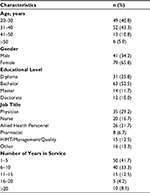  | Table 1 Demographic data (n=120) |
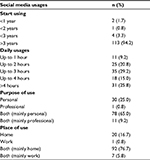  | Table 2 Pattern of social media usages (n=120) |
  | Table 3 Perception of social media benefits (n=120) |
  | Table 4 Perception of social media risks (n=120) |
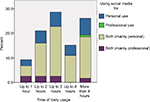  | Figure 1 Duration of the usage of social media. |
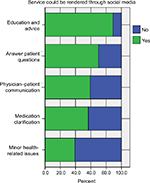  | Figure 2 Services rendered through social media. |
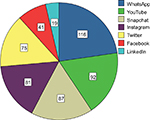  | Figure 3 Social media used by health-care professionals. |
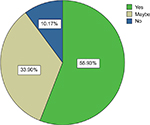  | Figure 4 Health-care professionals’ interest to use social media. |
In Table 1, we can detect that 65.8% of respondents were female and that >80% of the total sample size of participants were aged between 20 and 40 years. Also, more than half of the respondents (52.5%) had a Bachelor’s degree, and the highest number of participants were physicians with a response rate of 29.2%. In relation to work experience, 41.7% of the participants had <5 years of experience and 33.3% of them had been employed for 6–10 years.
According to Table 2, most of the respondents, 94.2%, used social media for >3 years, and 25.8% of them utilized social media >4 hours a day.
Perceptions of HCP on the use of social media are shown in Tables 3 and 4. Table 3 presents the positive insights of HCPs and their perceived benefits on the use of social media in health-care delivery. On the other hand, the perceived risk factors associated with the usage of social media in health-care services are shown in Table 4.
From Table 3, we can detect that more than half of the participants considered and responded “Yes definitively” that social media can help in health-care delivery (53.3%) and public health awareness (55.8%). If we take into account both responses “Yes definitely” and “Most of the time” together, we can notice that most of the participants agreed highly on the benefits of social media usage.
In Table 4, we can perceive that the majority of the respondents (54.2%) believed that the use of social media carries “sometimes” a potential risk for themselves, for the patients, and for the patients’ privacy. Also, 60% of the respondents thought that social media is not a risk for their professional image; for this question, 30% selected “Rarely” and 30%“Not at all”.
Related to the use of social media, Figure 1 indicates that most of the social media platforms were utilized mainly for personal use.
In Figure 2, it is observed that the majority of the respondents believed that social media is an ideal tool to provide education and advise patients. But they were more conservative about diagnosing minor health issues through social media.
The number of users of social media such as WhatsApp, You Tube, Snapchat, Instagram, Twitter, Facebook, and LinkedIn is shown in Figure 3. Here, we see that the most used platform is WhatsApp and the least used is LinkedIn.
Also, the interest of the participants to use social media is described in Figure 4. Most of the respondents expressed their interest to increase the use of social media (55.93%) for professional purposes; 33% of them were not sure about it and 10% were not at all interested in the usage of social media.
Discussion
From Table 1, we observe that HCPs participating in this study are constituted by physicians, nurses, pharmacists, allied health workers, HIMT personnel, and other persons, and it is appreciated that physicians constitute the largest number of participants (29.2%). Also, 75% have <10 years of experience.
In relation to the use of social media, we can observe in Table 2 that the majority of the participants (94.2%) have employed social media platforms for >3 years mainly for personal purposes (65%). Also, 90.8% of the respondents utilized social media for >1 hour a day, and the place of use for more than half of the respondents (76.7%) is at home.
According to Table 3, when we combine the responses given by the participants to “Yes definitely” and “Most of the time”, it is possible to detect that 66.6% of the respondents agreed that social media can be used to improve their professional knowledge. Also, 85% of them considered that social media can be a good tool for patient education and public health (84.1%). These results coincide with other studies carried out on this topic.15–17 For example, Househ15 found that clinicians used social media to read articles, establish contacts through networking, and share knowledge. Similarly, Kukreja et al17 observed that HCPs followed health information through Facebook and Twitter accounts.
Related to Table 4, most of the respondents were not sure about the risks involved in the use of social media. In this sense, they believed that “sometimes” the use of social media can be a potential risk for HCPs (54.2 %), a risk for patient health status (52.5%), damage professional image (30%), or breach patient privacy (53.3%). Also, a small percentage (5%) of the participants considered (Yes definitely) that social media had a minimal effect on their professional image. In addition, >15% respondents were confident that social media is a real threat for their professional career or for the patient health status (17.5%). Similar findings have been found in other studies related to the use of social media.18
Based on these results, it is convenient to point out that when using social media for health-related issues, there is a risk of publishing online private information on the patient’s diagnosis and medication, which can lead to legal judgments against the HCPs. Also, there is a potential risk that other patients will begin to self-medicate following that instruction or a particular information available on social networks without visiting the doctors. This can produce serious adverse health events. Likewise, inappropriate use of social media can lead to the breakdown of patient privacy. If this happens, HCPs can face serious lawsuits that affect their professional career. In reality, these are some of the main barriers to the use of social media by doctors.18–20
In terms of the duration of the usage of social media, we can observe in Figure 1 that the participants employ these platforms mainly for personal purposes; the professional uses of social media in respondents were minimal.
Concerning Figure 2, we can appreciate that more than half of the respondents believed that social media can provide HCPs with tools for health education and advice, for physician–patient communication, and for medication and clarification. Also, 60% were pessimistic on receiving the diagnosis or medication online for minor health-related issues.
In Figure 3, we found that out of 120 participants, 116 respondents used WhatsApp, 92 used YouTube, 87 used Snapchat, 81 used Instagram, 75 used Twitter, 41 used Facebook, and 19 used LinkedIn. These results indicated that WhatsApp is the most used social platform by 96.7% of the HCPs.
About the interest to use social media, Figure 4 points out that 55.93% of the participants want to use social media for professional purposes. However, 10.17% of the participants have no interest in using them, and the rest (33.90%) are not sure of their usefulness.
The general results of our research are supported by other studies carried out in the domain of health care.5,6,8,9,15,19,20 The findings about the benefits and risks reported by Ventola,5 Lim,8 Alsughayr,9 and de Martino et al6 coincide with our results. Similarly, the outcomes reported by Househ et al15,19 about the use and impact of social media on the health-care sector are in agreement with the conclusions of this study.
The major limitation of this study was the small sample size. Even though the questionnaire was widely circulated online for 3 months and required only 3 minutes to fill up, we did not receive response up to our expectation. We believe that the community may need more awareness about such activities. Also, the community must know how rapidly social media has been an integral part of the health-care industry. These two factors need further investigation. Another probable limitation was that the majority of the respondents were female. Here, several factors like societal and cultural limitations, privacy and security issues, and information and communications technology literacy come into play, and therefore, the responses were most likely to be affected by the culture and customs followed in Saudi Arabia.
In future research on this topic, we will increase the sample size of participants. Also, we will study the use of social media considering the gender and age of the users, and analyze which part of the day or times of the day maximum usage of the social media by various age groups of HCPs, both male and female, is made. Similarly, we expect to investigate the perception of HCPs on the quality of care provided through the association between social media and health-care delivery. In addition, it would be interesting to investigate the impact of social networks on the medical care of people affected by chronic diseases who connect with each other to share their pains and means of remedy. Likewise, it would be opportune to investigate the religious, personal, social, and security restrictions that limit the use of social media for health care, especially among women, in the Arab world.
Conclusion
The outcomes of this research indicate that the majority of HCPs are in agreement with the utility of social media in the provision of health services. In this sense, social media can represent a useful tool by which physicians may advertise their services and disseminate general health information. However, there are potential risks in the use of social networks that can have negative repercussions for patients and HCPs. This implies that precautions must be taken to avoid breaches of patient confidentiality and other problems that can result in legal action against health professionals damaging their image and professional prestige. The study also found that the participants are willing to employ social media for professional purposes.
Disclosure
The authors report no conflicts of interest in this work.
References
Perrin A. Social media usage: 2005–2015. Pew Internet Center Report. 2015. | ||
Facebook by the numbers: stats demographics & fun facts. Omnicoreagency.com; 2017. Available from: https://www.omnicoreagency.com/facebook-statistics/. Accessed December 26, 2017. | ||
The Social Clinic. The state of social media in Saudi Arabia. Available from: http://www.thesocialclinic.com/the-state-of-social- media-in-saudi-arabia-vol-3/. | ||
Penetration of leading social networks in Saudi Arabia as of 3rd quarter 2017. Statista2017. Available from: https://www.statista.com/statistics/284451/saudi-arabia-social-network-penetration/. | ||
Ventola CL. Social media and health care professionals: benefits, risks, and best practices. PT. 2014;39(7):491–499. | ||
de Martino D, D’Apolito R, McLawhorn AS, et al. Social media for patients: benefits and drawbacks. Curr Rev Musculoskelet Med. 2017;10(1):141–145. | ||
Hao J, Gao B. Advantages and disadvantages for nurses of using social media. J Prim Health Care Gen Pract. 2017;1(1):1–3. | ||
Lim WM. Social media in medical and health care: opportunities and challenges. Market Int Plan. 2016;34(7):964–976. | ||
Alsughayr A. Social media in healthcare: uses, risks, and barriers. Saudi J Med Sci. 2015;3(2):105–111. | ||
Alsobayel H. Use of social media for professional development by health care professionals: a cross-sectional web-based survey. JMIR Med Educ. 2016;2(2):e15. | ||
Ahmed SM, Alruways FA, Alsallum TF, Almutairi MM, Al-Subhi AS, Ababdulkarim AA. Opinion of healthcare professionals in the usage of social media for patient care in Majmaah, Saudi Arabia. Int J Public Health Sci. 2017;6(1):13–20. | ||
Questionnaire. Social media uses in health care delivery. Available from: https://goo.gl/forms/h9ATjjroHRdblbrx1. | ||
Radhakrishna RB. Tips for developing and testing questionnaires/instruments. J Exten. 2007;45(1):1TOT2. | ||
Brown S. Likert scale examples for surveys. ANR Program Evaluation. Iowa. | ||
Househ M. The use of social media in healthcare: organizational, clinical, and patient perspectives. Stud Health Technol Inform. 2013;183:244–248. | ||
Cooper A, Kar P. A new dawn: the role of social media in diabetes education. J Diabet Nurs. 2014;18(2):68–71. | ||
Kukreja P, Heck Sheehan A, Riggins J. Use of social media by pharmacy preceptors. Am J Pharm Educ. 2011;75(9):176. | ||
Arnett MR, Loewen JM, Romito LM. Use of social media by dental educators. J Dent Educ. 2013;77(11):1402–1412. | ||
Househ M, Borycki E, Kushniruk A. Empowering patients through social media: the benefits and challenges. Health Informatics J. 2014;20(1):50–58. | ||
Campbell L, Evans Y, Pumper M, Moreno MA. Social media use by physicians: a qualitative study of the new frontier of medicine. BMC Med Inform Decis Mak. 2016;16(91):91. |
 © 2018 The Author(s). This work is published and licensed by Dove Medical Press Limited. The full terms of this license are available at https://www.dovepress.com/terms.php and incorporate the Creative Commons Attribution - Non Commercial (unported, v3.0) License.
By accessing the work you hereby accept the Terms. Non-commercial uses of the work are permitted without any further permission from Dove Medical Press Limited, provided the work is properly attributed. For permission for commercial use of this work, please see paragraphs 4.2 and 5 of our Terms.
© 2018 The Author(s). This work is published and licensed by Dove Medical Press Limited. The full terms of this license are available at https://www.dovepress.com/terms.php and incorporate the Creative Commons Attribution - Non Commercial (unported, v3.0) License.
By accessing the work you hereby accept the Terms. Non-commercial uses of the work are permitted without any further permission from Dove Medical Press Limited, provided the work is properly attributed. For permission for commercial use of this work, please see paragraphs 4.2 and 5 of our Terms.
